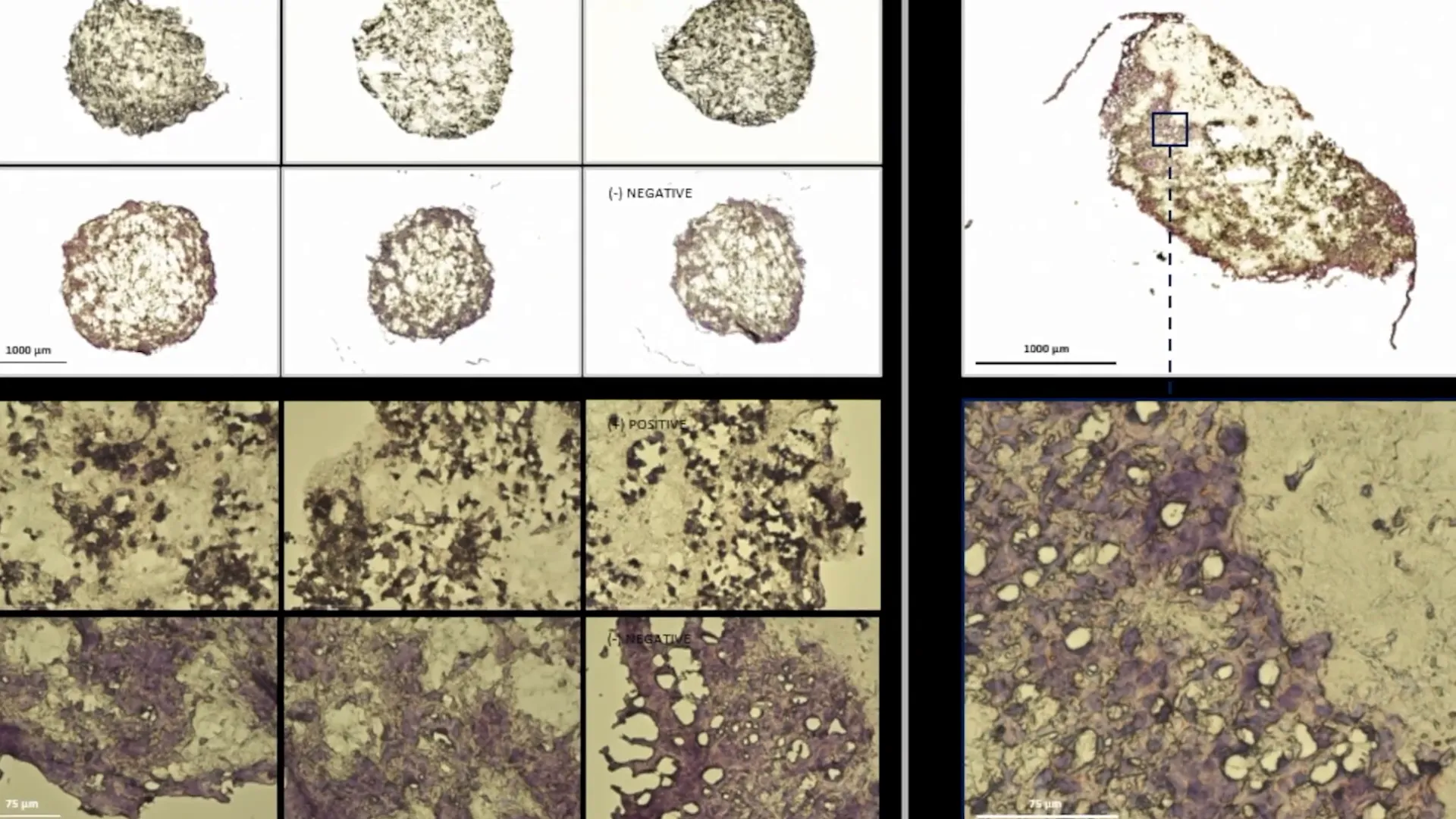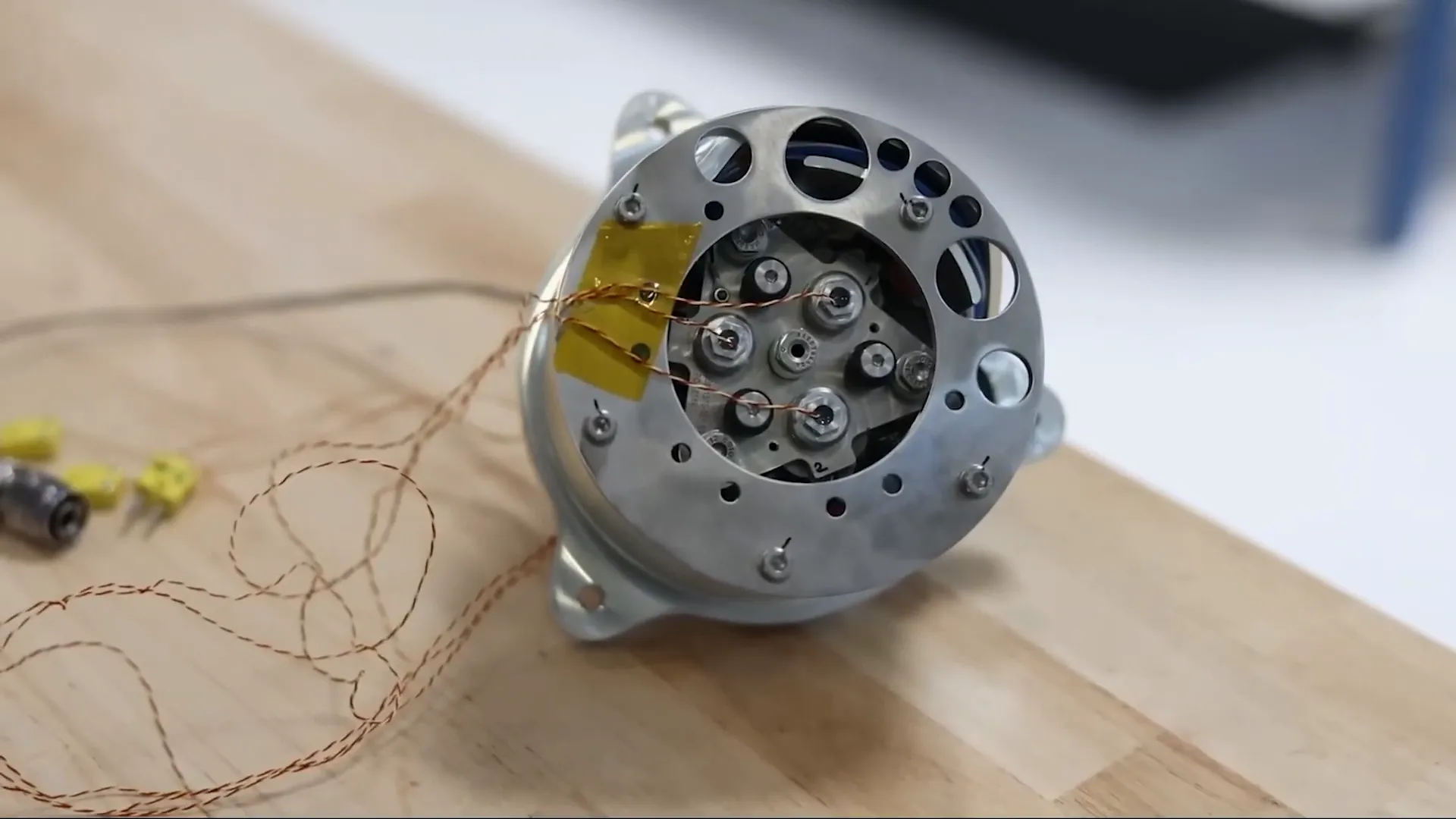Content
The Future is Now: Top 10 Emerging Technologies of 2025
The Future is Now: Top 10 Emerging Technologies of 2025
The Future is Now: Top 10 Emerging Technologies of 2025
Danny Roman
December 7, 2024




As we hurtle toward 2025, a wave of transformative technologies is set to reshape our world. From bioprinted organs to quantum computing, these innovations promise to tackle pressing global challenges and redefine industries. However, with great power comes great responsibility, and understanding the implications of these advancements is crucial.
🌟 Introduction to Emerging Technologies
The landscape of technology is evolving at breakneck speed, and the year 2025 is poised to showcase some of the most groundbreaking innovations yet. Emerging technologies are not merely concepts; they are becoming integral parts of our lives, pushing boundaries and redefining what we thought was possible. From healthcare to energy, these advancements promise to tackle some of the most pressing issues faced by humanity today. But as we embrace these innovations, we must also consider the ethical implications and societal impacts they bring.
🧬 Bioprinting: Revolutionizing Healthcare
Bioprinting isn’t just a futuristic idea; it’s here to change the game in healthcare. Imagine a world where organ shortages are a thing of the past. With bioprinting, that dream is inching closer to reality. Using cutting-edge 3D printing technology, scientists can layer living cells and biomaterials to create functional organs. Think kidneys, livers, and even hearts—all made to order!

What makes bioprinting a potential lifesaver is its ability to use a patient’s own cells. This drastically reduces the risk of organ rejection and eliminates the need for long-term immunosuppressants. With over 100,000 people in the U.S. waiting for transplants, this breakthrough could save countless lives and relieve a global crisis.
But hold your horses—this innovation isn't without its hurdles. While simpler tissues like skin have been successfully bioprinted, creating complex organs with intricate vascular networks is still a challenge. These networks are crucial for transporting oxygen and nutrients, which makes their accurate replication essential for functional organs.

Ethical dilemmas also shadow this technology. If bioprinting becomes commercially viable, will it be accessible to everyone? Or will it deepen healthcare inequalities, favoring the wealthy? And what about the moral questions surrounding the commodification of human body parts? The path to widespread bioprinting will require careful regulation and ethical consideration to ensure it serves humanity equitably.
⚛️ Quantum Computing: A New Frontier in Problem Solving
Quantum computing is not just a buzzword; it's a revolution waiting to happen. Unlike traditional computers that operate on binary—zeroes and ones—quantum computers use qubits. These qubits can represent multiple states simultaneously, allowing them to tackle complex calculations at lightning speeds.

Take drug discovery, for instance. Quantum computers can simulate drug interactions at an atomic level, drastically speeding up research timelines. This could lead to breakthroughs in treatment options that we can only dream of today.
However, with great power comes great responsibility. Quantum computing poses a significant threat to cybersecurity. These machines could crack encryption methods that protect sensitive data, from banking to government communications. The race is on to develop quantum-resistant cryptography before these computers hit the mainstream.
🤖 Artificial Intelligence: The Creative Partner
Artificial intelligence is evolving beyond automation; it's becoming a creative partner. By 2025, AI will assist in composing music, designing architecture, and even formulating new scientific theories. Imagine AI systems discovering new materials or optimizing solar cell efficiency. The guesswork is being eliminated!

Yet, this power isn't without scrutiny. AI's "black box" nature means even developers struggle to understand how decisions are made, raising concerns about trust and accountability. Plus, AI can inherit biases from the data it's trained on, skewing results. While the potential is enormous, responsible use is crucial.
☢️ Fusion Energy: The Holy Grail of Clean Power
Fusion energy is often dubbed the holy grail of clean energy. Unlike nuclear fission, which splits atoms, fusion combines them, mimicking the process that powers the sun. The end result? Nearly unlimited energy with zero carbon emissions and minimal radioactive waste!

By 2025, we anticipate small-scale fusion reactors making their debut, providing a consistent energy source that’s not reliant on weather conditions like solar or wind. But don’t pop the champagne just yet; achieving this isn’t easy. Fusion reactors need extreme conditions—temperatures hotter than the sun’s core—and building systems that can contain this energy is a monumental challenge.
Should scientists overcome these obstacles, fusion energy could completely redefine the global energy landscape.
🌍 Carbon Capture Technology: Fighting Climate Change
As the climate crisis escalates, carbon capture technology emerges as a potential hero. This technology doesn’t just aim to reduce emissions; it actively removes CO2 from the atmosphere. From engineered microbes that convert CO2 into biofuels to large-scale industrial filters that trap carbon at its source, these systems are poised to play a vital role in combating climate change.
However, scalability is a significant issue. Current systems are costly and energy-intensive, raising questions about long-term feasibility. Plus, there’s the risk of unintended consequences—how do we ensure that releasing carbon-rich byproducts won’t harm ecosystems? While carbon capture holds immense promise, its success hinges on solving these challenges.
🌐 Augmented Reality: A New Dimension of Interaction
Augmented reality (AR) is breaking free from the confines of gaming. By 2025, AR will become an everyday utility, enhancing how we engage with the world. Picture walking through a city and seeing real-time directions, restaurant reviews, or translations displayed on your glasses. It’s not just a fantasy; it’s the future!
Industries like construction and healthcare are already harnessing AR’s power. Surgeons can use AR overlays during operations to minimize errors, while architects visualize projects before they’re built. But this rapid adoption brings its own set of challenges—privacy and data security concerns loom large. With devices constantly collecting information, how do we ensure that this data is used responsibly?
🧪 Synthetic Biology: Engineering Life for a Sustainable Future
Synthetic biology combines biology and engineering to create custom organisms that tackle major challenges. By 2025, scientists will use this technology to engineer drought-resistant crops, biodegradable plastics, and even bacteria that can clean up oil spills. These innovations hold the potential to address food insecurity and environmental degradation.
However, the field is fraught with risks. Genetically engineered organisms could unintentionally disrupt ecosystems if released without safeguards. There’s also the real concern of misuse—creating engineered organisms could lead to dangerous applications in the wrong hands. As thrilling as synthetic biology is, it needs rigorous oversight to ensure it’s used for good.
🌈 Augmented Reality: Transforming Everyday Life
Augmented reality (AR) is stepping out of the gaming world and into the fabric of our daily lives. By 2025, AR will be an indispensable tool, enhancing our interactions with the environment around us. Imagine navigating a bustling city with real-time directions, reading reviews of your favorite restaurants, or translating signs on the fly—right before your eyes!
The impact of AR isn’t limited to just the casual user. Industries like healthcare and construction are already reaping the benefits. Surgeons utilize AR overlays to visualize critical information during operations, drastically reducing the margin for error. Architects can now walk through virtual models before a single brick is laid, ensuring their designs are both innovative and practical.
However, with great power comes great responsibility. The rapid adoption of AR raises serious concerns about privacy and data security. Devices that constantly collect data about our surroundings pose a risk. We must ask ourselves: how do we protect our personal information while enjoying the conveniences of AR technology? The balance between innovation and ethics is more crucial than ever.
🌱 Synthetic Biology: Custom Solutions for Global Challenges
Synthetic biology is emerging as a beacon of hope for some of the planet's most pressing issues. By 2025, this field will enable scientists to engineer organisms tailored to tackle challenges like food insecurity and pollution. Imagine drought-resistant crops that thrive in arid conditions, biodegradable plastics that reduce landfill waste, and bacteria designed to clean up oil spills.
These advancements promise to revolutionize agriculture and environmental management. However, the excitement surrounding synthetic biology must be tempered with caution. Genetically engineered organisms could inadvertently disrupt local ecosystems if not managed properly. Plus, the potential for misuse looms large—creating dangerous organisms could lead to catastrophic consequences. Rigorous oversight and ethical guidelines are essential to harness its full potential safely.
🏔️ High Altitude Platform Stations: Bridging the Digital Divide
High Altitude Platform Stations (HAPS) are set to revolutionize internet access for millions. These flying cell towers, operating at altitudes of around 20 kilometers, can provide connectivity to remote areas where traditional infrastructure falters. By 2025, millions of individuals in underserved regions could finally gain internet access, bridging a significant digital divide.

HAPS aren't just about connectivity; they offer rapid deployment capabilities, making them invaluable during natural disasters when immediate communication is critical. However, the road to implementation is fraught with challenges. Keeping these platforms airborne requires cutting-edge materials and energy systems. Navigating international airspace regulations adds another layer of complexity to their deployment.
Moreover, environmental concerns such as interference with aviation and wildlife must be addressed. Still, the promise of HAPS represents a bold step toward a more connected world. With the right strategies, we can ensure that no one gets left behind in the digital age.
🔒 Privacy Enhancing Technologies: Safeguarding Our Data
In a world driven by data, privacy-enhancing technologies (PETs) are becoming indispensable. From advanced encryption methods to federated learning, PETs ensure that sensitive data can be analyzed without compromising personal information. Imagine being able to conduct healthcare research using patient data while keeping identities completely secure. That’s the power of PETs!

Homomorphic encryption, for instance, allows computations on encrypted data without ever needing to decrypt it. This could revolutionize how we handle sensitive information across various sectors, particularly in healthcare. But with great potential comes significant challenges. Many PETs are computationally intensive, potentially slowing down systems or raising costs.
Furthermore, widespread adoption necessitates collaboration across industries, which can be a daunting task. The future of PETs holds immense promise for safeguarding our privacy, but their scalability and efficiency will determine their long-term success.
🚀 Space Manufacturing: The New Industrial Revolution
By 2025, space manufacturing is poised to transition from a theoretical concept to a tangible reality. The unique conditions of zero gravity offer unprecedented opportunities for creating advanced materials that are difficult or impossible to produce on Earth. Think ultra-pure fiber optics, new metal alloys, and even pharmaceuticals crafted with unmatched precision.

These innovations could revolutionize industries such as telecommunications, healthcare, and aerospace. Furthermore, space factories could significantly reduce the costs associated with space exploration. By manufacturing essential components on-site—like spacecraft parts or solar panels—we could eliminate the need to launch everything from Earth, paving the way for more sustainable missions.
However, the challenges are monumental. Launching materials and equipment into orbit is still prohibitively expensive, and building reliable manufacturing systems in the harsh environment of space requires cutting-edge engineering solutions. Yet, the potential rewards are staggering, pushing the boundaries of what humanity can achieve and opening new frontiers of innovation.
🛡️ The Responsibility of Innovation
The technologies of 2025 are not just about innovation; they come with an immense responsibility. As we embrace these advancements, we must also address their risks and ethical implications. Each breakthrough has the potential to redefine our world, but we must ensure that they benefit humanity as a whole.
From augmented reality to space manufacturing, the landscape is evolving rapidly. We have the power to shape the future, but it’s up to us to do it wisely. Let’s engage in thoughtful discussions about how we can harness these technologies for the greater good, ensuring that progress doesn’t come at the expense of our values.
What innovations excite you the most? Share your thoughts in the comments below and let's explore this thrilling future together!
As we hurtle toward 2025, a wave of transformative technologies is set to reshape our world. From bioprinted organs to quantum computing, these innovations promise to tackle pressing global challenges and redefine industries. However, with great power comes great responsibility, and understanding the implications of these advancements is crucial.
🌟 Introduction to Emerging Technologies
The landscape of technology is evolving at breakneck speed, and the year 2025 is poised to showcase some of the most groundbreaking innovations yet. Emerging technologies are not merely concepts; they are becoming integral parts of our lives, pushing boundaries and redefining what we thought was possible. From healthcare to energy, these advancements promise to tackle some of the most pressing issues faced by humanity today. But as we embrace these innovations, we must also consider the ethical implications and societal impacts they bring.
🧬 Bioprinting: Revolutionizing Healthcare
Bioprinting isn’t just a futuristic idea; it’s here to change the game in healthcare. Imagine a world where organ shortages are a thing of the past. With bioprinting, that dream is inching closer to reality. Using cutting-edge 3D printing technology, scientists can layer living cells and biomaterials to create functional organs. Think kidneys, livers, and even hearts—all made to order!

What makes bioprinting a potential lifesaver is its ability to use a patient’s own cells. This drastically reduces the risk of organ rejection and eliminates the need for long-term immunosuppressants. With over 100,000 people in the U.S. waiting for transplants, this breakthrough could save countless lives and relieve a global crisis.
But hold your horses—this innovation isn't without its hurdles. While simpler tissues like skin have been successfully bioprinted, creating complex organs with intricate vascular networks is still a challenge. These networks are crucial for transporting oxygen and nutrients, which makes their accurate replication essential for functional organs.

Ethical dilemmas also shadow this technology. If bioprinting becomes commercially viable, will it be accessible to everyone? Or will it deepen healthcare inequalities, favoring the wealthy? And what about the moral questions surrounding the commodification of human body parts? The path to widespread bioprinting will require careful regulation and ethical consideration to ensure it serves humanity equitably.
⚛️ Quantum Computing: A New Frontier in Problem Solving
Quantum computing is not just a buzzword; it's a revolution waiting to happen. Unlike traditional computers that operate on binary—zeroes and ones—quantum computers use qubits. These qubits can represent multiple states simultaneously, allowing them to tackle complex calculations at lightning speeds.

Take drug discovery, for instance. Quantum computers can simulate drug interactions at an atomic level, drastically speeding up research timelines. This could lead to breakthroughs in treatment options that we can only dream of today.
However, with great power comes great responsibility. Quantum computing poses a significant threat to cybersecurity. These machines could crack encryption methods that protect sensitive data, from banking to government communications. The race is on to develop quantum-resistant cryptography before these computers hit the mainstream.
🤖 Artificial Intelligence: The Creative Partner
Artificial intelligence is evolving beyond automation; it's becoming a creative partner. By 2025, AI will assist in composing music, designing architecture, and even formulating new scientific theories. Imagine AI systems discovering new materials or optimizing solar cell efficiency. The guesswork is being eliminated!

Yet, this power isn't without scrutiny. AI's "black box" nature means even developers struggle to understand how decisions are made, raising concerns about trust and accountability. Plus, AI can inherit biases from the data it's trained on, skewing results. While the potential is enormous, responsible use is crucial.
☢️ Fusion Energy: The Holy Grail of Clean Power
Fusion energy is often dubbed the holy grail of clean energy. Unlike nuclear fission, which splits atoms, fusion combines them, mimicking the process that powers the sun. The end result? Nearly unlimited energy with zero carbon emissions and minimal radioactive waste!

By 2025, we anticipate small-scale fusion reactors making their debut, providing a consistent energy source that’s not reliant on weather conditions like solar or wind. But don’t pop the champagne just yet; achieving this isn’t easy. Fusion reactors need extreme conditions—temperatures hotter than the sun’s core—and building systems that can contain this energy is a monumental challenge.
Should scientists overcome these obstacles, fusion energy could completely redefine the global energy landscape.
🌍 Carbon Capture Technology: Fighting Climate Change
As the climate crisis escalates, carbon capture technology emerges as a potential hero. This technology doesn’t just aim to reduce emissions; it actively removes CO2 from the atmosphere. From engineered microbes that convert CO2 into biofuels to large-scale industrial filters that trap carbon at its source, these systems are poised to play a vital role in combating climate change.
However, scalability is a significant issue. Current systems are costly and energy-intensive, raising questions about long-term feasibility. Plus, there’s the risk of unintended consequences—how do we ensure that releasing carbon-rich byproducts won’t harm ecosystems? While carbon capture holds immense promise, its success hinges on solving these challenges.
🌐 Augmented Reality: A New Dimension of Interaction
Augmented reality (AR) is breaking free from the confines of gaming. By 2025, AR will become an everyday utility, enhancing how we engage with the world. Picture walking through a city and seeing real-time directions, restaurant reviews, or translations displayed on your glasses. It’s not just a fantasy; it’s the future!
Industries like construction and healthcare are already harnessing AR’s power. Surgeons can use AR overlays during operations to minimize errors, while architects visualize projects before they’re built. But this rapid adoption brings its own set of challenges—privacy and data security concerns loom large. With devices constantly collecting information, how do we ensure that this data is used responsibly?
🧪 Synthetic Biology: Engineering Life for a Sustainable Future
Synthetic biology combines biology and engineering to create custom organisms that tackle major challenges. By 2025, scientists will use this technology to engineer drought-resistant crops, biodegradable plastics, and even bacteria that can clean up oil spills. These innovations hold the potential to address food insecurity and environmental degradation.
However, the field is fraught with risks. Genetically engineered organisms could unintentionally disrupt ecosystems if released without safeguards. There’s also the real concern of misuse—creating engineered organisms could lead to dangerous applications in the wrong hands. As thrilling as synthetic biology is, it needs rigorous oversight to ensure it’s used for good.
🌈 Augmented Reality: Transforming Everyday Life
Augmented reality (AR) is stepping out of the gaming world and into the fabric of our daily lives. By 2025, AR will be an indispensable tool, enhancing our interactions with the environment around us. Imagine navigating a bustling city with real-time directions, reading reviews of your favorite restaurants, or translating signs on the fly—right before your eyes!
The impact of AR isn’t limited to just the casual user. Industries like healthcare and construction are already reaping the benefits. Surgeons utilize AR overlays to visualize critical information during operations, drastically reducing the margin for error. Architects can now walk through virtual models before a single brick is laid, ensuring their designs are both innovative and practical.
However, with great power comes great responsibility. The rapid adoption of AR raises serious concerns about privacy and data security. Devices that constantly collect data about our surroundings pose a risk. We must ask ourselves: how do we protect our personal information while enjoying the conveniences of AR technology? The balance between innovation and ethics is more crucial than ever.
🌱 Synthetic Biology: Custom Solutions for Global Challenges
Synthetic biology is emerging as a beacon of hope for some of the planet's most pressing issues. By 2025, this field will enable scientists to engineer organisms tailored to tackle challenges like food insecurity and pollution. Imagine drought-resistant crops that thrive in arid conditions, biodegradable plastics that reduce landfill waste, and bacteria designed to clean up oil spills.
These advancements promise to revolutionize agriculture and environmental management. However, the excitement surrounding synthetic biology must be tempered with caution. Genetically engineered organisms could inadvertently disrupt local ecosystems if not managed properly. Plus, the potential for misuse looms large—creating dangerous organisms could lead to catastrophic consequences. Rigorous oversight and ethical guidelines are essential to harness its full potential safely.
🏔️ High Altitude Platform Stations: Bridging the Digital Divide
High Altitude Platform Stations (HAPS) are set to revolutionize internet access for millions. These flying cell towers, operating at altitudes of around 20 kilometers, can provide connectivity to remote areas where traditional infrastructure falters. By 2025, millions of individuals in underserved regions could finally gain internet access, bridging a significant digital divide.

HAPS aren't just about connectivity; they offer rapid deployment capabilities, making them invaluable during natural disasters when immediate communication is critical. However, the road to implementation is fraught with challenges. Keeping these platforms airborne requires cutting-edge materials and energy systems. Navigating international airspace regulations adds another layer of complexity to their deployment.
Moreover, environmental concerns such as interference with aviation and wildlife must be addressed. Still, the promise of HAPS represents a bold step toward a more connected world. With the right strategies, we can ensure that no one gets left behind in the digital age.
🔒 Privacy Enhancing Technologies: Safeguarding Our Data
In a world driven by data, privacy-enhancing technologies (PETs) are becoming indispensable. From advanced encryption methods to federated learning, PETs ensure that sensitive data can be analyzed without compromising personal information. Imagine being able to conduct healthcare research using patient data while keeping identities completely secure. That’s the power of PETs!

Homomorphic encryption, for instance, allows computations on encrypted data without ever needing to decrypt it. This could revolutionize how we handle sensitive information across various sectors, particularly in healthcare. But with great potential comes significant challenges. Many PETs are computationally intensive, potentially slowing down systems or raising costs.
Furthermore, widespread adoption necessitates collaboration across industries, which can be a daunting task. The future of PETs holds immense promise for safeguarding our privacy, but their scalability and efficiency will determine their long-term success.
🚀 Space Manufacturing: The New Industrial Revolution
By 2025, space manufacturing is poised to transition from a theoretical concept to a tangible reality. The unique conditions of zero gravity offer unprecedented opportunities for creating advanced materials that are difficult or impossible to produce on Earth. Think ultra-pure fiber optics, new metal alloys, and even pharmaceuticals crafted with unmatched precision.

These innovations could revolutionize industries such as telecommunications, healthcare, and aerospace. Furthermore, space factories could significantly reduce the costs associated with space exploration. By manufacturing essential components on-site—like spacecraft parts or solar panels—we could eliminate the need to launch everything from Earth, paving the way for more sustainable missions.
However, the challenges are monumental. Launching materials and equipment into orbit is still prohibitively expensive, and building reliable manufacturing systems in the harsh environment of space requires cutting-edge engineering solutions. Yet, the potential rewards are staggering, pushing the boundaries of what humanity can achieve and opening new frontiers of innovation.
🛡️ The Responsibility of Innovation
The technologies of 2025 are not just about innovation; they come with an immense responsibility. As we embrace these advancements, we must also address their risks and ethical implications. Each breakthrough has the potential to redefine our world, but we must ensure that they benefit humanity as a whole.
From augmented reality to space manufacturing, the landscape is evolving rapidly. We have the power to shape the future, but it’s up to us to do it wisely. Let’s engage in thoughtful discussions about how we can harness these technologies for the greater good, ensuring that progress doesn’t come at the expense of our values.
What innovations excite you the most? Share your thoughts in the comments below and let's explore this thrilling future together!
As we hurtle toward 2025, a wave of transformative technologies is set to reshape our world. From bioprinted organs to quantum computing, these innovations promise to tackle pressing global challenges and redefine industries. However, with great power comes great responsibility, and understanding the implications of these advancements is crucial.
🌟 Introduction to Emerging Technologies
The landscape of technology is evolving at breakneck speed, and the year 2025 is poised to showcase some of the most groundbreaking innovations yet. Emerging technologies are not merely concepts; they are becoming integral parts of our lives, pushing boundaries and redefining what we thought was possible. From healthcare to energy, these advancements promise to tackle some of the most pressing issues faced by humanity today. But as we embrace these innovations, we must also consider the ethical implications and societal impacts they bring.
🧬 Bioprinting: Revolutionizing Healthcare
Bioprinting isn’t just a futuristic idea; it’s here to change the game in healthcare. Imagine a world where organ shortages are a thing of the past. With bioprinting, that dream is inching closer to reality. Using cutting-edge 3D printing technology, scientists can layer living cells and biomaterials to create functional organs. Think kidneys, livers, and even hearts—all made to order!

What makes bioprinting a potential lifesaver is its ability to use a patient’s own cells. This drastically reduces the risk of organ rejection and eliminates the need for long-term immunosuppressants. With over 100,000 people in the U.S. waiting for transplants, this breakthrough could save countless lives and relieve a global crisis.
But hold your horses—this innovation isn't without its hurdles. While simpler tissues like skin have been successfully bioprinted, creating complex organs with intricate vascular networks is still a challenge. These networks are crucial for transporting oxygen and nutrients, which makes their accurate replication essential for functional organs.

Ethical dilemmas also shadow this technology. If bioprinting becomes commercially viable, will it be accessible to everyone? Or will it deepen healthcare inequalities, favoring the wealthy? And what about the moral questions surrounding the commodification of human body parts? The path to widespread bioprinting will require careful regulation and ethical consideration to ensure it serves humanity equitably.
⚛️ Quantum Computing: A New Frontier in Problem Solving
Quantum computing is not just a buzzword; it's a revolution waiting to happen. Unlike traditional computers that operate on binary—zeroes and ones—quantum computers use qubits. These qubits can represent multiple states simultaneously, allowing them to tackle complex calculations at lightning speeds.

Take drug discovery, for instance. Quantum computers can simulate drug interactions at an atomic level, drastically speeding up research timelines. This could lead to breakthroughs in treatment options that we can only dream of today.
However, with great power comes great responsibility. Quantum computing poses a significant threat to cybersecurity. These machines could crack encryption methods that protect sensitive data, from banking to government communications. The race is on to develop quantum-resistant cryptography before these computers hit the mainstream.
🤖 Artificial Intelligence: The Creative Partner
Artificial intelligence is evolving beyond automation; it's becoming a creative partner. By 2025, AI will assist in composing music, designing architecture, and even formulating new scientific theories. Imagine AI systems discovering new materials or optimizing solar cell efficiency. The guesswork is being eliminated!

Yet, this power isn't without scrutiny. AI's "black box" nature means even developers struggle to understand how decisions are made, raising concerns about trust and accountability. Plus, AI can inherit biases from the data it's trained on, skewing results. While the potential is enormous, responsible use is crucial.
☢️ Fusion Energy: The Holy Grail of Clean Power
Fusion energy is often dubbed the holy grail of clean energy. Unlike nuclear fission, which splits atoms, fusion combines them, mimicking the process that powers the sun. The end result? Nearly unlimited energy with zero carbon emissions and minimal radioactive waste!

By 2025, we anticipate small-scale fusion reactors making their debut, providing a consistent energy source that’s not reliant on weather conditions like solar or wind. But don’t pop the champagne just yet; achieving this isn’t easy. Fusion reactors need extreme conditions—temperatures hotter than the sun’s core—and building systems that can contain this energy is a monumental challenge.
Should scientists overcome these obstacles, fusion energy could completely redefine the global energy landscape.
🌍 Carbon Capture Technology: Fighting Climate Change
As the climate crisis escalates, carbon capture technology emerges as a potential hero. This technology doesn’t just aim to reduce emissions; it actively removes CO2 from the atmosphere. From engineered microbes that convert CO2 into biofuels to large-scale industrial filters that trap carbon at its source, these systems are poised to play a vital role in combating climate change.
However, scalability is a significant issue. Current systems are costly and energy-intensive, raising questions about long-term feasibility. Plus, there’s the risk of unintended consequences—how do we ensure that releasing carbon-rich byproducts won’t harm ecosystems? While carbon capture holds immense promise, its success hinges on solving these challenges.
🌐 Augmented Reality: A New Dimension of Interaction
Augmented reality (AR) is breaking free from the confines of gaming. By 2025, AR will become an everyday utility, enhancing how we engage with the world. Picture walking through a city and seeing real-time directions, restaurant reviews, or translations displayed on your glasses. It’s not just a fantasy; it’s the future!
Industries like construction and healthcare are already harnessing AR’s power. Surgeons can use AR overlays during operations to minimize errors, while architects visualize projects before they’re built. But this rapid adoption brings its own set of challenges—privacy and data security concerns loom large. With devices constantly collecting information, how do we ensure that this data is used responsibly?
🧪 Synthetic Biology: Engineering Life for a Sustainable Future
Synthetic biology combines biology and engineering to create custom organisms that tackle major challenges. By 2025, scientists will use this technology to engineer drought-resistant crops, biodegradable plastics, and even bacteria that can clean up oil spills. These innovations hold the potential to address food insecurity and environmental degradation.
However, the field is fraught with risks. Genetically engineered organisms could unintentionally disrupt ecosystems if released without safeguards. There’s also the real concern of misuse—creating engineered organisms could lead to dangerous applications in the wrong hands. As thrilling as synthetic biology is, it needs rigorous oversight to ensure it’s used for good.
🌈 Augmented Reality: Transforming Everyday Life
Augmented reality (AR) is stepping out of the gaming world and into the fabric of our daily lives. By 2025, AR will be an indispensable tool, enhancing our interactions with the environment around us. Imagine navigating a bustling city with real-time directions, reading reviews of your favorite restaurants, or translating signs on the fly—right before your eyes!
The impact of AR isn’t limited to just the casual user. Industries like healthcare and construction are already reaping the benefits. Surgeons utilize AR overlays to visualize critical information during operations, drastically reducing the margin for error. Architects can now walk through virtual models before a single brick is laid, ensuring their designs are both innovative and practical.
However, with great power comes great responsibility. The rapid adoption of AR raises serious concerns about privacy and data security. Devices that constantly collect data about our surroundings pose a risk. We must ask ourselves: how do we protect our personal information while enjoying the conveniences of AR technology? The balance between innovation and ethics is more crucial than ever.
🌱 Synthetic Biology: Custom Solutions for Global Challenges
Synthetic biology is emerging as a beacon of hope for some of the planet's most pressing issues. By 2025, this field will enable scientists to engineer organisms tailored to tackle challenges like food insecurity and pollution. Imagine drought-resistant crops that thrive in arid conditions, biodegradable plastics that reduce landfill waste, and bacteria designed to clean up oil spills.
These advancements promise to revolutionize agriculture and environmental management. However, the excitement surrounding synthetic biology must be tempered with caution. Genetically engineered organisms could inadvertently disrupt local ecosystems if not managed properly. Plus, the potential for misuse looms large—creating dangerous organisms could lead to catastrophic consequences. Rigorous oversight and ethical guidelines are essential to harness its full potential safely.
🏔️ High Altitude Platform Stations: Bridging the Digital Divide
High Altitude Platform Stations (HAPS) are set to revolutionize internet access for millions. These flying cell towers, operating at altitudes of around 20 kilometers, can provide connectivity to remote areas where traditional infrastructure falters. By 2025, millions of individuals in underserved regions could finally gain internet access, bridging a significant digital divide.

HAPS aren't just about connectivity; they offer rapid deployment capabilities, making them invaluable during natural disasters when immediate communication is critical. However, the road to implementation is fraught with challenges. Keeping these platforms airborne requires cutting-edge materials and energy systems. Navigating international airspace regulations adds another layer of complexity to their deployment.
Moreover, environmental concerns such as interference with aviation and wildlife must be addressed. Still, the promise of HAPS represents a bold step toward a more connected world. With the right strategies, we can ensure that no one gets left behind in the digital age.
🔒 Privacy Enhancing Technologies: Safeguarding Our Data
In a world driven by data, privacy-enhancing technologies (PETs) are becoming indispensable. From advanced encryption methods to federated learning, PETs ensure that sensitive data can be analyzed without compromising personal information. Imagine being able to conduct healthcare research using patient data while keeping identities completely secure. That’s the power of PETs!

Homomorphic encryption, for instance, allows computations on encrypted data without ever needing to decrypt it. This could revolutionize how we handle sensitive information across various sectors, particularly in healthcare. But with great potential comes significant challenges. Many PETs are computationally intensive, potentially slowing down systems or raising costs.
Furthermore, widespread adoption necessitates collaboration across industries, which can be a daunting task. The future of PETs holds immense promise for safeguarding our privacy, but their scalability and efficiency will determine their long-term success.
🚀 Space Manufacturing: The New Industrial Revolution
By 2025, space manufacturing is poised to transition from a theoretical concept to a tangible reality. The unique conditions of zero gravity offer unprecedented opportunities for creating advanced materials that are difficult or impossible to produce on Earth. Think ultra-pure fiber optics, new metal alloys, and even pharmaceuticals crafted with unmatched precision.

These innovations could revolutionize industries such as telecommunications, healthcare, and aerospace. Furthermore, space factories could significantly reduce the costs associated with space exploration. By manufacturing essential components on-site—like spacecraft parts or solar panels—we could eliminate the need to launch everything from Earth, paving the way for more sustainable missions.
However, the challenges are monumental. Launching materials and equipment into orbit is still prohibitively expensive, and building reliable manufacturing systems in the harsh environment of space requires cutting-edge engineering solutions. Yet, the potential rewards are staggering, pushing the boundaries of what humanity can achieve and opening new frontiers of innovation.
🛡️ The Responsibility of Innovation
The technologies of 2025 are not just about innovation; they come with an immense responsibility. As we embrace these advancements, we must also address their risks and ethical implications. Each breakthrough has the potential to redefine our world, but we must ensure that they benefit humanity as a whole.
From augmented reality to space manufacturing, the landscape is evolving rapidly. We have the power to shape the future, but it’s up to us to do it wisely. Let’s engage in thoughtful discussions about how we can harness these technologies for the greater good, ensuring that progress doesn’t come at the expense of our values.
What innovations excite you the most? Share your thoughts in the comments below and let's explore this thrilling future together!
As we hurtle toward 2025, a wave of transformative technologies is set to reshape our world. From bioprinted organs to quantum computing, these innovations promise to tackle pressing global challenges and redefine industries. However, with great power comes great responsibility, and understanding the implications of these advancements is crucial.
🌟 Introduction to Emerging Technologies
The landscape of technology is evolving at breakneck speed, and the year 2025 is poised to showcase some of the most groundbreaking innovations yet. Emerging technologies are not merely concepts; they are becoming integral parts of our lives, pushing boundaries and redefining what we thought was possible. From healthcare to energy, these advancements promise to tackle some of the most pressing issues faced by humanity today. But as we embrace these innovations, we must also consider the ethical implications and societal impacts they bring.
🧬 Bioprinting: Revolutionizing Healthcare
Bioprinting isn’t just a futuristic idea; it’s here to change the game in healthcare. Imagine a world where organ shortages are a thing of the past. With bioprinting, that dream is inching closer to reality. Using cutting-edge 3D printing technology, scientists can layer living cells and biomaterials to create functional organs. Think kidneys, livers, and even hearts—all made to order!

What makes bioprinting a potential lifesaver is its ability to use a patient’s own cells. This drastically reduces the risk of organ rejection and eliminates the need for long-term immunosuppressants. With over 100,000 people in the U.S. waiting for transplants, this breakthrough could save countless lives and relieve a global crisis.
But hold your horses—this innovation isn't without its hurdles. While simpler tissues like skin have been successfully bioprinted, creating complex organs with intricate vascular networks is still a challenge. These networks are crucial for transporting oxygen and nutrients, which makes their accurate replication essential for functional organs.

Ethical dilemmas also shadow this technology. If bioprinting becomes commercially viable, will it be accessible to everyone? Or will it deepen healthcare inequalities, favoring the wealthy? And what about the moral questions surrounding the commodification of human body parts? The path to widespread bioprinting will require careful regulation and ethical consideration to ensure it serves humanity equitably.
⚛️ Quantum Computing: A New Frontier in Problem Solving
Quantum computing is not just a buzzword; it's a revolution waiting to happen. Unlike traditional computers that operate on binary—zeroes and ones—quantum computers use qubits. These qubits can represent multiple states simultaneously, allowing them to tackle complex calculations at lightning speeds.

Take drug discovery, for instance. Quantum computers can simulate drug interactions at an atomic level, drastically speeding up research timelines. This could lead to breakthroughs in treatment options that we can only dream of today.
However, with great power comes great responsibility. Quantum computing poses a significant threat to cybersecurity. These machines could crack encryption methods that protect sensitive data, from banking to government communications. The race is on to develop quantum-resistant cryptography before these computers hit the mainstream.
🤖 Artificial Intelligence: The Creative Partner
Artificial intelligence is evolving beyond automation; it's becoming a creative partner. By 2025, AI will assist in composing music, designing architecture, and even formulating new scientific theories. Imagine AI systems discovering new materials or optimizing solar cell efficiency. The guesswork is being eliminated!

Yet, this power isn't without scrutiny. AI's "black box" nature means even developers struggle to understand how decisions are made, raising concerns about trust and accountability. Plus, AI can inherit biases from the data it's trained on, skewing results. While the potential is enormous, responsible use is crucial.
☢️ Fusion Energy: The Holy Grail of Clean Power
Fusion energy is often dubbed the holy grail of clean energy. Unlike nuclear fission, which splits atoms, fusion combines them, mimicking the process that powers the sun. The end result? Nearly unlimited energy with zero carbon emissions and minimal radioactive waste!

By 2025, we anticipate small-scale fusion reactors making their debut, providing a consistent energy source that’s not reliant on weather conditions like solar or wind. But don’t pop the champagne just yet; achieving this isn’t easy. Fusion reactors need extreme conditions—temperatures hotter than the sun’s core—and building systems that can contain this energy is a monumental challenge.
Should scientists overcome these obstacles, fusion energy could completely redefine the global energy landscape.
🌍 Carbon Capture Technology: Fighting Climate Change
As the climate crisis escalates, carbon capture technology emerges as a potential hero. This technology doesn’t just aim to reduce emissions; it actively removes CO2 from the atmosphere. From engineered microbes that convert CO2 into biofuels to large-scale industrial filters that trap carbon at its source, these systems are poised to play a vital role in combating climate change.
However, scalability is a significant issue. Current systems are costly and energy-intensive, raising questions about long-term feasibility. Plus, there’s the risk of unintended consequences—how do we ensure that releasing carbon-rich byproducts won’t harm ecosystems? While carbon capture holds immense promise, its success hinges on solving these challenges.
🌐 Augmented Reality: A New Dimension of Interaction
Augmented reality (AR) is breaking free from the confines of gaming. By 2025, AR will become an everyday utility, enhancing how we engage with the world. Picture walking through a city and seeing real-time directions, restaurant reviews, or translations displayed on your glasses. It’s not just a fantasy; it’s the future!
Industries like construction and healthcare are already harnessing AR’s power. Surgeons can use AR overlays during operations to minimize errors, while architects visualize projects before they’re built. But this rapid adoption brings its own set of challenges—privacy and data security concerns loom large. With devices constantly collecting information, how do we ensure that this data is used responsibly?
🧪 Synthetic Biology: Engineering Life for a Sustainable Future
Synthetic biology combines biology and engineering to create custom organisms that tackle major challenges. By 2025, scientists will use this technology to engineer drought-resistant crops, biodegradable plastics, and even bacteria that can clean up oil spills. These innovations hold the potential to address food insecurity and environmental degradation.
However, the field is fraught with risks. Genetically engineered organisms could unintentionally disrupt ecosystems if released without safeguards. There’s also the real concern of misuse—creating engineered organisms could lead to dangerous applications in the wrong hands. As thrilling as synthetic biology is, it needs rigorous oversight to ensure it’s used for good.
🌈 Augmented Reality: Transforming Everyday Life
Augmented reality (AR) is stepping out of the gaming world and into the fabric of our daily lives. By 2025, AR will be an indispensable tool, enhancing our interactions with the environment around us. Imagine navigating a bustling city with real-time directions, reading reviews of your favorite restaurants, or translating signs on the fly—right before your eyes!
The impact of AR isn’t limited to just the casual user. Industries like healthcare and construction are already reaping the benefits. Surgeons utilize AR overlays to visualize critical information during operations, drastically reducing the margin for error. Architects can now walk through virtual models before a single brick is laid, ensuring their designs are both innovative and practical.
However, with great power comes great responsibility. The rapid adoption of AR raises serious concerns about privacy and data security. Devices that constantly collect data about our surroundings pose a risk. We must ask ourselves: how do we protect our personal information while enjoying the conveniences of AR technology? The balance between innovation and ethics is more crucial than ever.
🌱 Synthetic Biology: Custom Solutions for Global Challenges
Synthetic biology is emerging as a beacon of hope for some of the planet's most pressing issues. By 2025, this field will enable scientists to engineer organisms tailored to tackle challenges like food insecurity and pollution. Imagine drought-resistant crops that thrive in arid conditions, biodegradable plastics that reduce landfill waste, and bacteria designed to clean up oil spills.
These advancements promise to revolutionize agriculture and environmental management. However, the excitement surrounding synthetic biology must be tempered with caution. Genetically engineered organisms could inadvertently disrupt local ecosystems if not managed properly. Plus, the potential for misuse looms large—creating dangerous organisms could lead to catastrophic consequences. Rigorous oversight and ethical guidelines are essential to harness its full potential safely.
🏔️ High Altitude Platform Stations: Bridging the Digital Divide
High Altitude Platform Stations (HAPS) are set to revolutionize internet access for millions. These flying cell towers, operating at altitudes of around 20 kilometers, can provide connectivity to remote areas where traditional infrastructure falters. By 2025, millions of individuals in underserved regions could finally gain internet access, bridging a significant digital divide.

HAPS aren't just about connectivity; they offer rapid deployment capabilities, making them invaluable during natural disasters when immediate communication is critical. However, the road to implementation is fraught with challenges. Keeping these platforms airborne requires cutting-edge materials and energy systems. Navigating international airspace regulations adds another layer of complexity to their deployment.
Moreover, environmental concerns such as interference with aviation and wildlife must be addressed. Still, the promise of HAPS represents a bold step toward a more connected world. With the right strategies, we can ensure that no one gets left behind in the digital age.
🔒 Privacy Enhancing Technologies: Safeguarding Our Data
In a world driven by data, privacy-enhancing technologies (PETs) are becoming indispensable. From advanced encryption methods to federated learning, PETs ensure that sensitive data can be analyzed without compromising personal information. Imagine being able to conduct healthcare research using patient data while keeping identities completely secure. That’s the power of PETs!

Homomorphic encryption, for instance, allows computations on encrypted data without ever needing to decrypt it. This could revolutionize how we handle sensitive information across various sectors, particularly in healthcare. But with great potential comes significant challenges. Many PETs are computationally intensive, potentially slowing down systems or raising costs.
Furthermore, widespread adoption necessitates collaboration across industries, which can be a daunting task. The future of PETs holds immense promise for safeguarding our privacy, but their scalability and efficiency will determine their long-term success.
🚀 Space Manufacturing: The New Industrial Revolution
By 2025, space manufacturing is poised to transition from a theoretical concept to a tangible reality. The unique conditions of zero gravity offer unprecedented opportunities for creating advanced materials that are difficult or impossible to produce on Earth. Think ultra-pure fiber optics, new metal alloys, and even pharmaceuticals crafted with unmatched precision.

These innovations could revolutionize industries such as telecommunications, healthcare, and aerospace. Furthermore, space factories could significantly reduce the costs associated with space exploration. By manufacturing essential components on-site—like spacecraft parts or solar panels—we could eliminate the need to launch everything from Earth, paving the way for more sustainable missions.
However, the challenges are monumental. Launching materials and equipment into orbit is still prohibitively expensive, and building reliable manufacturing systems in the harsh environment of space requires cutting-edge engineering solutions. Yet, the potential rewards are staggering, pushing the boundaries of what humanity can achieve and opening new frontiers of innovation.
🛡️ The Responsibility of Innovation
The technologies of 2025 are not just about innovation; they come with an immense responsibility. As we embrace these advancements, we must also address their risks and ethical implications. Each breakthrough has the potential to redefine our world, but we must ensure that they benefit humanity as a whole.
From augmented reality to space manufacturing, the landscape is evolving rapidly. We have the power to shape the future, but it’s up to us to do it wisely. Let’s engage in thoughtful discussions about how we can harness these technologies for the greater good, ensuring that progress doesn’t come at the expense of our values.
What innovations excite you the most? Share your thoughts in the comments below and let's explore this thrilling future together!





